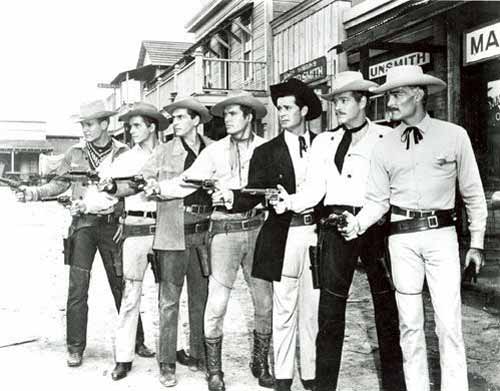
The late James Garner is third from the right in this photo of stars in Warner Brothers’ TV westerns from the late 1950s. The others are, left to right, Will Hutchins (“Sugarfoot”), Peter Brown (“Lawman”), Jack Kelly(“Maverick”), Ty Hardin (“Bronco”), Garner (also “Maverick”), Wayde Preston (“Colt .45”) and John Russell (also “Lawman”).
 Last month, a progressive actor equally at ease playing a ne’er-do-well gambler, private eye or astronaut died: James Garner.
Last month, a progressive actor equally at ease playing a ne’er-do-well gambler, private eye or astronaut died: James Garner.
He was the best among favorite actors – and still lives on old black-and-white western reruns.
As he recounted in his highly recommended memoir “The Garner Files,” co-written with Jon Winokur, Garner was a staunch liberal who marched on Washington in 1963 with Diahann Carroll, Paul Newman, Charlton Heston, Harry Belafonte, Burt Lancaster, Marlon Brando, Sammy Davis Jr., author James Baldwin and others – all using/risking their celebrity status for Civil Rights. Garner famously stood up to the Warner Brothers corporation, too, and, as a cigarette smoker, nevertheless thought tobacco should be illegal – and marijuana decriminalized.
Also last month, Peoria actor and TV host James Wilhelm (from WTVP-TV 47’s “Illinois Adventures”) appeared at the Apollo Theater in downtown Peoria in a one-man show, “Wyatt Earp: My Side of The Story,” and the American Heroes Channel (formerly the Military Channel) launched its six-part docudrama series “Gunslingers.”
Both shows stress historical truth and the “real story” behind the icons we’re familiar with.
Like Garner’s death, such doses of reality aren’t always comfortable.
I prefer the whimsical stories, the myths – just as I’d rather read various adventures about King Arthur and his Round Table, Ulysses or samurai, pirates or Vikings, and “1001 Arabian Nights” or assorted Native American warriors – and even “Lord of the Rings,” “Star Wars” and Peorian Philip Jose Farmer’s “Riverworld” stories – to pedestrian tales of primitive bowmen, Dark Ages kings, ruthless barbarians, etc.
Escape? Maybe, although the feeling of sanctuary comes closer to the feeling.
“Gunslingers” is trying to immerse viewers in the real backgrounds of historic figures and their conflicts. It’s an ambitious, interesting undertaking. Besides the premiere episode (“Wyatt Earp: The Tombstone Vendetta”), the series featured “Billy the Kid: The Phantom of Lincoln County” and this month offers “Jesse James: The South’s Last Rebel” (Aug. 3), “Wild Bill Hickok: Marksman – and Marked Man” (Aug. 10), “John Wesley Hardin: The Dark Heart of Texas” (Aug. 17), and “Tom Horn: Grim Reaper of the Rockies” (Aug. 24).
Similarly, Wilhelm – whose production hopefully will be offered again throughout central Illinois –must touch on Wyatt Earp’s roots in Monmouth, run-ins with the law in Peoria, and more mundane, if entertaining, experiences in Henry, Beardstown and, yes, the Wild West.
Westerns are one of a handful of genuine American contributions to popular culture, including jazz and rock ’n’ roll, comic books and Hollywood. But when TV expanded in the early 1950s, singing cowboys and dance-hall girls (who rarely danced), rustlers and ranchers, railroad crooks and horse thieves, outlaws and lawmen, gunmen and gamblers, Apache renegades and Sioux braves all filled the country’s living-room screens.
After dime novels, movies first lay the groundwork, of course, from Bronco Billy, William S. Hart and Tom Mix to Gene Autry, Roy Rogers and Randolph Scott. Personal cinema favorites: “High Noon,” “The Searchers” and “Shane,” plus director John Ford’s classic “cavalry trilogy”: “Fort Apache,” “Rio Grande” and “She Wore A Yellow Ribbon.”
But television is where westerns really found their audience, young and old, and rode – spurs flashing – into my heart. There they remain, as I retreat to the refuge of stark contrasts of television’s depiction of good and evil. Occasionally, I start to watch “Stagecoach” or “Red River,” but I long for shorter narratives from hour-long episodes of “Maverick” with Garner, “Cheyenne” with Clint Walker or “Rawhide” with Clint Eastwood, to the 30-minute gems.
The half-hour programs are the best, with faster action, simpler plots, sheriffs and marshals triumphing over corrupt bankers or arrogant wagon masters: “The Life and Legend of Wyatt Earp” and “Bat Masterson,” “Lawman” and “The Rifleman,” “Have Gun, Will Travel” and “Marshall Dillon,” “The Adventures of Rin Tin Tin” and “The Adventures of Wild Bill Hickok,” “The Lone Ranger” and “The Range Rider”(with Dickie Jones, who also passed on last month), “Buffalo Bill Jr.” (Jones again) and “Broken Arrow,” “Yancy Derringer” and “Wanted: Dead or Alive,” and “Tales of Wells Fargo” and “The Rebel” …
There are contradictions, sure. These old TV westerns are wholesome yet violent, idealistic but crude, a bit too “male, pale and stale” for contemporary audiences, although somehow universal.
More than anything except family and church, TV westerns provide me a comfort zone, a fantasy with certainty, like Camelot with Galahad and Uruk with Gilgamesh.
Myths of heroes overcoming the odds remain more desirable than ordinary guys with feet of clay and hearts of stone.
A 19th century journalist said it best in “The Man Who Shot Liberty Valance” – “This is the West, sir. When the legend becomes fact, print the legend.”
To James Garner, and all of us: Happy trails!
Contact Bill at Bill.Knight@hotmail.com; his twice-weekly columns are archived at:
billknightcolumn.blogspot.com
